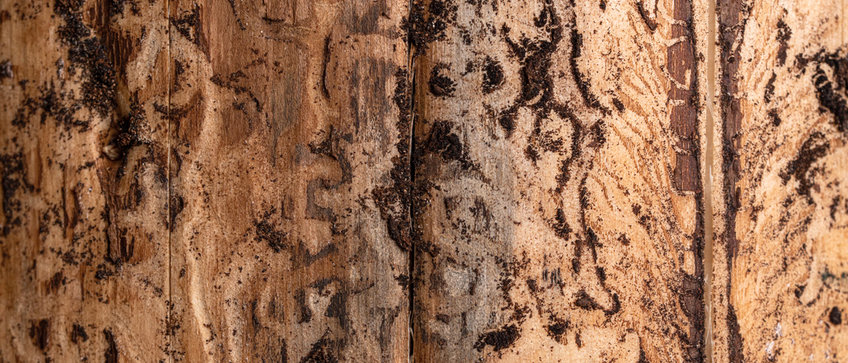
Chemical ecology of bark and ambrosia beetle associations with microbes
We aim to understand how bark and ambrosia beetles interact with fungi and bacteria and how this influences their success in colonizing trees.
Bark and ambrosia beetles (Coleoptera: Curculionidae) are a highly diverse group of insects found in forests throughout much of the world. Some species are major pests of wild trees and trees on plantations, with mass outbreaks that kill millions of hectares of trees per year.
Both bark and ambrosia beetles have a remarkable ability to colonize the bark and wood of trees, substrates that have a very low nutrient content and are often well protected by chemical defenses. This success is often attributed to their associated microbes.
We are investigating how fungal and bacterial associates might help beetles to survive on trees by providing nutrients, protecting beetles from antagonistic microbes, and detoxifying tree defense compounds. Our research includes a variety of different microbes (bacteria, yeasts and filamentous fungi) found within the beetle or as free-living associates.
We apply various methods, including microbiological culturing, sequencing and transcriptomics, beetle behavioral and performance assays, chemical isolation and characterization, and metabolic pathway elucidation. One goal is to isolate microbial and insect genes encoding enzymes involved in nutritional acquisition, detoxification of tree defenses and the biosynthesis of microbial defenses active against antagonistic microbes. Such genes will be manipulated to test hypotheses about the ecological functions of biosynthetic or catabolic pathways, and their expression monitored to determine how insect-microbe and microbe-microbe interactions are regulated.
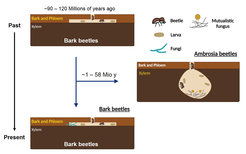
I) Projects involving ambrosia beetles and their associated microbes
The nutritional and defensive function of Alloascoidea hylecoeti, the fungal symbiont of the ship-timber beetle Elateroides dermestoides
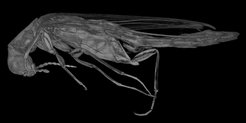
Participating researchers: Yu Pan, Dr. Maximilian Lehenberger, Dr. Laure Martinelli
The ship-timber beetle (Coleoptera: Lymexylidae) is one of the few non-social, fungus-farming ambrosia beetles. In contrast to other ambrosia beetles, where brood-care is the rule, a female of E. dermestoides lays one egg within the bark of a tree (both softwoods and hardwoods are colonized) and dies afterwards. The larva has to survive up to three years within a very competitive environment to complete its life cycle. However, little is known about the beetle or its microbial associate, a yeast-like fungus in the Saccharomycetales. In this project, we are examining the nutritional value of the associated mutualistic fungus as well as its defensive secondary metabolites and comparing them with those of other bark and ambrosia beetle fungi, antagonistic fungi and common wood degrading fungi. In addition, the pathways involved in the biosynthesis of secondary metabolites in A. hylecoeti will also be studied.
The role of yeasts associated with bark and ambrosia beetles
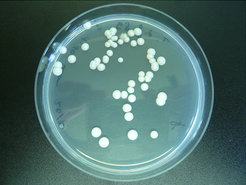
Participating researchers: Leandro Santiago Padilla (Master student), Dr. Maximilian Lehenberger
Collaborators: Dr. Dineshkumar Kandasamy (Lund University, Sweden)
Insects are well known for their symbiotic association with specific yeasts, which can serve nutritional but also defensive roles. One famous example is the fruit-fly Drosophila, where several studies on symbiotic yeasts have already been performed. Yeasts (especially in the genera Candida and Pichia) have been frequently isolated from bark and ambrosia beetles, but almost nothing is known about their function and possible beneficial effects they may have on their beetle hosts. We want to compare the nutritional value of several beetle-associated yeasts to gather novel insights into a possible role as a food source for the beetles, including behavioral assays with beetles and larvae to investigate attractiveness. Possible defensive functions will be examined via analysis of secondary metabolites and volatiles, and bioassays with common antagonistic fungi.
Elemental composition of bark and ambrosia beetle fungi
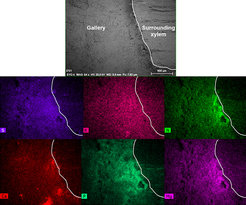
Participating researchers: Stefanie Ungerer (Bachelor project), Dr. Maximilian Lehenberger
Collaborators: Dr. Gros (TLLLR)
For decades, mutualistic bark and ambrosia beetle fungi have been thought to be extremely rich in nutrients, as they serve as the sole source of nutrition to the beetles. Past studies already revealed that nests of ambrosia beetles are highly enriched with essential elements such as phosphorus, magnesium, calcium, potassium, and nitrogen. However, a comparative study investigating the total elemental composition of several mutualistic beetle fungi has not been carried out.
II) Projects focused on Ips typographus bark beetle and its associated microbes
Millions of hectares of Norway spruce (Picea abies) in Germany and surrounding countries are killed each year by the Eurasian spruce bark beetle, Ips typographus. Outbreaks are increasing due to warming temperatures that speed up the beetle’s life cycle and increase tree stress. The colonization success of I. typographus relies on the presence of symbionts, in particular free-living blue stain fungi from the order Ophiostomatales. Although the exact benefits and extent of these associations are not yet well understood, these ectosymbiotic fungi may exhaust host tree defenses, metabolize tree defense compounds, provide nutritional benefits to larvae and adults, or protect them from harmful microbes. The many questions surrounding this multipartite ecosystem are the focus of various projects in our group, all aiming to gain knowledge about the ecological interactions and strategies responsible for the tree-killing success of I. typographus.

Effect of ophiostomatoid fungi on Ips typographus nutrition and fitness
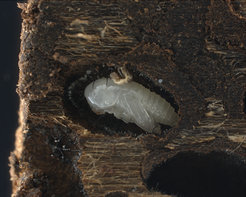
Participating researcher: Emily Puckett
Collaborators: Dr. Dineshkumar Kandasamy (Lund University, Sweden), Dr. Axel Schmidt (Conifer Defense Group)
Tree bark represents a challenging substrate for insects due not only to its defense compounds, but also to its low concentration of accessible nutrients. Like many insects, bark beetles face a nutritional mismatch between what they require and what their hosts can provide. This mismatch is often overcome with the help of a microbial symbiont that either lives within the insect’s organs or can be found in its environment. In addition to provisioning nutrients that cannot be found in high enough quantities within the host tissue, microbes can also provide insects with access to otherwise nutritionally inert substrates. Using a combination of chemical and behavioral assays, we are attempting to establish whether one or more of the microbial associates of Ips typographus function as its nutritional symbionts.
The role of bacterial symbionts for bark beetle ecology
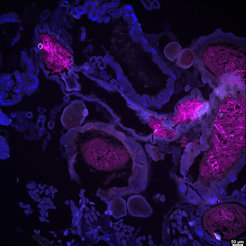
Participating researchers: Ana Patricia Baños Quintana
Co-supervisor: Prof. Dr. Martin Kaltenpoth, Department of Insect Symbiosis
The Ips typographus microbiome has already been characterized, but its role in the bark beetle colonization success is not well understood. Bacterial symbionts in the gut could also play an important role in promoting beetle attack by supplying critical nutrients or detoxifying host tree defenses. We are investigating the role of the gut microbial community in promoting bark beetle development on spruce by a combination of culture-dependent and -independent microbiota profiling, fluorescence in-situ hybridization, metagenomics and metatranscriptomics of beetle guts, manipulative bioassays, and chemical analytics. Knowledge about the role of microbial gut symbionts in the bark beetle life cycle may yield new insights into how insects are able to survive on trees with low nutrient content and abundant chemical defenses, as well as suggesting new strategies to combat this pest.
Toxicity of spruce phenolics to Ips typographus and associates
Participating researchers: Sadia Zaman Shormee (Master student)
Collaborators: Dr. Dineshkumar Kandasamy (Lund University, Sweden), Dr. Henrik Hartmann (Plant Allocation Group, MPI for Biogeochemistry)
Norway spruce tree (Picea abies) is a dominant tree species in Europe. This tree species frequently get attacked by the destructive beetle, Ips typographus. When a spruce tree is under attack it defends itself by producing different types of chemical compounds including phenolics. In this project, we are working with four major phenolic compounds, namely, astringin, catechin, isorhapontin, and taxifolin. We are interested to study the effect of these compounds on the bark beetle as well as on its associated fungi symbionts. With a semi-artificial diet-based approach we are investigating the toxic effect of these compounds on the bark beetle growth and development. Another aim of this project is to study the role of symbiotic fungi in detoxification. For this we use bioassays to investigate the changes in phenolic content in the presence of fungus.
Metabolism of spruce defensive phenolic compounds by a bark beetle and a symbiotic fungus
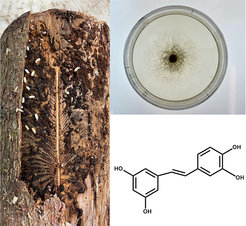
Participating researchers: Baoyu Hu, Dr. Ruo Sun
Natural interactions involving plants, herbivore insects and their symbiotic fungi are ubiquitous in terrestrial ecosystems. Norway spruce is susceptible to attack by the Eurasian spruce bark beetle Ips typographus and its symbiotic fungus. The symbiont is vectored into the host tree during bark beetle attack, and this infestation is hypothesized to enhance bark beetle development by reducing the levels of spruce defensive chemicals. Besides oleoresins, defensive phenolic compounds are thought to protect Norway spruce from pest attack and fungal infection. However, the mechanism by which bark beetles and their fungal associates have counter-adapted to spruce defensive phenolic compounds remains unclear. In this project, we aim to reveal the detoxification strategies employed by the bark beetle and its symbiont to overcome spruce defense. First, bioassays will be conducted to detect the influence of spruce phenolic chemicals on bark beetles with or without their symbiotic fungi present. Secondly, the pathways of phenolic catabolism will be determined in both the bark beetle and its fungal associate. Subsequently, metabolic mechanisms will be explored at the protein and gene levels. Last, we hope to understand how the interaction of the bark beetle and its associated fungi achieve successful colonization of the host tree.
The role of phenolic substances in the interaction of bark beetle and an entomopathogenic fungus
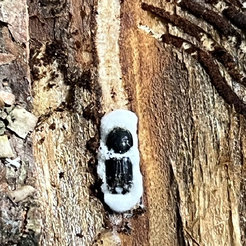
Participating researchers: Baoyu Hu, Dr. Ruo Sun
Norway spruce (Picea abies) produces chemical defenses such as terpenes and phenolics to protect itself from herbivores and pathogens. However, in natural systems, Norway spruce is susceptible to be attacked by the Eurasian spruce bark beetle Ips typographus. Entomopathogenic fungi are natural insect pathogens that can cause disease and thus control a large number of arthropod pest species, including bark beetles. It is known that certain herbivores can recruit plant chemical defenses and use them to fend off pathogens. Thus, in our project, we will investigate the metabolic ability of the entomopathogenic fungus to degrade phenolic defense compounds found in bark beetles attacking Norway spruce trees. Moreover, we will search for the genes and proteins of the entomopathogen involved in these degradative processes.
Role of tree-killing bark beetle-associated fungi in terpenoid detoxification
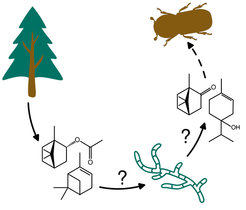
Participating researchers: Dr. Laure Martinelli
Collaborators: Dr. Dineshkumar Kandasamy (Lund University, Sweden)
In order to colonize the tree successfully, I. typographus and its mutualistic symbionts need to cope with various chemical defenses, including the terpenoid-rich resin. Previous studies showed that the volatile fraction of the resin, especially the monoterpenes, could be used in the colonization process. Ips typographus can oxidize the dominant host monoterpene α-pinene to cis-verbenol, an aggregation pheromone involved in the attraction of conspecifics for a mass attack. Additionally, previous work indicated that I. typographus responds to volatiles biosynthesized by their ophiostomatoid symbionts to help identify suitable colonization sites and maintaining specific beetle-fungi associations. However, little is known about ability of these ectosymbionts to metabolize mono- and sesqui-terpenes from the host tree oleoresins.
This project aims to study terpenoid metabolism of various I. typographus-associated fungi (Grosmannia penicillata, G. europhioides, Endoconidiophora polonica and Ophiostoma bicolor) by investigating the ability of the fungi to detoxify spruce resin terpenoids, determining the products, and assessing their effect on the bark beetle. We are also investigating correlation between metabolite and gene expression profiles to decipher fungal metabolic pathways involved in terpenoid metabolism. We also hope to genetically modify fungi to alter their terpenoid metabolism in order to assess the effects of such metabolism on bark beetle performance and behavior.
Identification of new natural products in bark beetle associated fungi
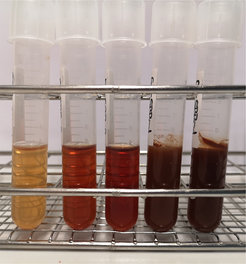
Participating researchers: Dr. Christiane Förster
Fungi are in general well known for their enormous capability to produce natural products, also known as specialized metabolites, which are not required for normal growth, but are essential for their interactions with other organisms in their environment. In addition, there is a great interest in these compounds for applications in human medicine, e.g. as antibiotics. The genes involved in the formation of a specialized metabolite are typically located close to each other in the fungal genome and form so-called biosynthetic gene clusters (BGCs), many of which are activated only under certain environmental conditions (e.g. stress due to nutrient deficiency, ambient temperature, or competition with other microbes). Within the bark beetle holobiont, production of such compounds by free-living fungal associates of I. typographus could promote colonization of the tree by the latter by suppressing host tree defenses (via mycotoxins) or fighting off harmful microbes (via antibiotics), including enemies of the bark beetle such as the entomopathogenic fungus Beauveria bassiana and common antagonistic fungi such as Trichoderma spp. or Penicillium spp.. However, the conditions leading to BGC activation, the actual identity of compounds, and their ecological roles are unknown.
In this project, we aim to investigate the production of new natural products in several I. typographus-associated fungi (E. polonica, G. penicillata, O. bicolor, and Cylindrobasidium ipidophilum) and explore their ecological relevance and contribution to successful colonization of the host tree by the bark beetle. By using various cultivation conditions to activate BGCs and consequently trigger natural product biosynthesis, followed by comparative mass spectrometry-based metabolomics, isolation, chemical characterization, and bioassays, we hope to discover and identify new specialized metabolites with relevant bioactivities. Another goal is to link natural product biosynthesis to their corresponding BGCs by a transcriptomic approach, which will allow manipulation of the fungal genes and more in-depth study of the ecological functions of these compounds.
Role of endosymbiotic gut bacteria of Hylobius abietis in detoxification of terpenes
Participating researchers: Kristina Kshatriya, Dr. Axel Schmidt (Conifer Defense Group)
The pine weevil (Hylobius abietis) is a major pest in European conifer forests where adults feed on the bark and cambium of Norway spruce and pine seedlings. Conifers are protected against bark-feeding herbivores by a complex mixture of secondary metabolites, mainly terpenoid-based oleoresins, and phenolic compounds. Therefore, adult pine weevils must cope with a complex mixture of noxious secondary metabolites in their diet, in addition to the problem of utilizing a food source that mainly consists of lignocellulose.
Many insects are known to harbor symbiotic microorganisms in their digestive system that allow the host to subsist on suboptimal diets by enhancing digestion efficiency, supplementing the diet with limiting vitamins or amino acids, or detoxifying plant secondary metabolites. However, little is known about degradation of lignin or mono-, and sesquiterpenes, as well as diterpene resin acids, the components of coniferous resin by symbiotic microorganisms.
We are exploring how the pine weevil copes with high concentrations of terpenes present in the host bark and cambium, by elucidating the metabolic fate of these compounds and their effect on the beetle. In order to understand the possible role of gut microorganisms in terpene detoxification as well as in wood digestion, we are using culture-dependent and -independent methods as well as metabolic and genomic analyses to functionally characterize the pine weevil’s gut microbiota. Elucidating the fate of terpenes in this system will shed some light on how insects cope with plant induced defenses and how some symbionts allow their hosts to exploit otherwise inaccessible food sources.










